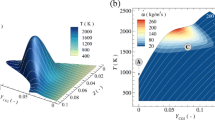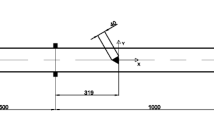Abstract
A numerical investigation of a bluff-body stabilised nonpremixedflame, and the corresponding nonreacting flow, has been performed withdifferential Reynolds-stress models (DRSMs). The equilibrium chemistry model is employed and an assumed-shape beta function PDFapproach is used to represent the interaction between turbulence andchemistry. The Reynolds flux of the mixture fraction is obtained from atransport equation, hence a full second moment closure is used. Toclarify the applicability of the existing DRSMs in this complex flame,several models, including LRR-IP model, JM model, SSG model as well as amodified LRR-IP model, have been applied and evaluated. The existingmodels, with default values of the coefficients, cannot provide overallsatisfactory predictions for this challenging test case. The standardLRR-IP model over predicts the centreline velocity decay rate, andtherefore does not perform satisfactory. The modified LRR-IP model, withmodel constant C ∈1 = 1.6 instead of the standard value1.44 (here named BM-M1), gives better results for the mean velocity.However in the nonreacting case this does not lead to improvement inpredicting rms fluctuating velocities especially downstream of therecirculation zone. Motivated by the need to improve the prediction, anew modification of the LRR-IP model is proposed (BM-M2), with modelconstant C 2 = 0.7in the pressure strain correlation rather thanthe standard value 0.6. With the new modified model, a verysignificant improvement of the prediction of flow field is obtained inthe nonreacting case, whereas in the reacting case the prediction ofthe flow field is of the same overall quality as with BM-M1. This showsthat some DRSMs have different behaviour in the nonreacting case andthe reacting case. In the reacting case also the mean and variance ofmixture fraction are considered and it is found that the best resultsare obtained with the BM-M1 model, with SSG as second best. Combiningthe results for flow field and mixture fraction field it is concludedthat the BM-M1 model is recommended for further studies of thisbluff-body stabilised flame. Grid independence of the result isdemonstrated.
Similar content being viewed by others
References
Craft, T.J. and Launder, B.E., Computation of impinging flows using second-moment closures. In: Proceedings of the 8th Symposium on Turbulent Shear Flows, TUMunich, Germany (1991) pp. 851–856.
Daly, B.J. and Harlow, F.H., Transport equations in turbulence. Phys. Fluids 13 (1970) 2634–2649.
Dally, B.B. and Masri, A.R., Flow and mixing fields of turbulent bluff-body jets and flames. Combust. Theory Modeling 2 (1998) 193–219.
Dally, B.B., Masri, A.R., Barlow, R.S. and Fiechtner, G.J., Instantaneous and mean compositional structure of bluff-body stabilized nonpremixed flame. Combust. Flame 114 (1998) 119–148.
Fu, S., Launder, B.E. and Tselepidakis, D.P., Accommodating the effects of high strain rates in modeling the pressure-strain correlation. Mechanical Engineering Department Report TFD/87/5, University of Manchester Institute of Science and Technology (1987).
Hanjalic, K. and Launder, B.E., A Reynolds stress model of turbulence and its application to thin shear flows. J. Fluid Mech. 52 (1972) 609–638.
Hanjalic, K. and Jakirlic, S., Second-moment turbulence closure modelling. In: Launder, B. and Sandham, N. (eds.), Closure Strategies for Turbulent and Transitional Flows. Cambridge University Press, Cambridge (2002) pp. 47–101.
Hossain, M., Jones, J.C. and Malalasekera, W., Modelling of a bluff-body nonpremixed flame using a coupled radiation/flamelet combustion model. Flow, Turbulence and Combustion 67 (2001) 217–234.
Jenny, P., Pope, S.B., Muradoglu, M. and Caughey, D.A., PDF simulations of a bluff-body stabilized flow. J. Comput. Phys. 169 (2001) 1–23.
Jones, W.P. and Musonge, P., Closure of the Reynolds stress and scalar flux equations. Phys. Fluids 31 (1988) 3589–3604.
Jones, W.P., Turbulence modelling and numerical solution methods for variable density and combusting flows. In: Libby, P. and Williams, F. (eds.), Turbulent Reacting Flows. Academic Press, London (1994) pp. 309–374.
Kim, S.H., Huh, K.Y. and Tao, L., Application of the elliptic conditional moment closure model to a two-dimensional nonpremixed methanol bluff-body flame. Combust. Flame 120 (2000) 75–90.
Kim, S.H. and Huh, K.Y., Use of the conditional moment closure model to predict NO formation in a turbulent CH4/H2 flame over a bluff-body. Combust. Flame 130 (2002) 94–111.
Launder, B.E., Reece, G.J. and Rodi, W., Progress in the development of a Reynolds-stress turbulence closure. J. Fluid Mech. 68 (1975) 537–566.
Li, G., Naud, B. and Roekaerts, D., The effect of grid and turbulence model on the simulation of a bluff-body flame with Reynolds-stress model. In: Barlow, R.S. and Pitsch, H. (eds.), Proceedings of the 6th International Workshop on Measurement and Computation of Turbulent Nonpremixed Flames, Japan. http://ww.ca.sandia.gov/TNF (2002) pp. 65–66.
Masri, A. R., http://www.mech.eng.usyd.edu.au/thermofluids/tnf6/tnf6bb.htm, The University of Sydney, dataset HM1E.
Masri, A.R., Computation of bluff-body stabilized jets and flames. In: Proceedings of 5th International Workshop on Measurement and Computation of Turbulent Nonpremixed Flames, Delft, The Netherlands. http://ww.ca.sandia.gov/TNF (2000) section 3.
McGuirk, J.J. and Rodi, W., The calculation of three dimensional turbulent free jets. In: Durst, F., Launder, B.E., Schmit, F.W. and Whitelaw, J.H. (eds.), Proceedings of the 1st Symposium on Turbulent Shear Flows. Springer-Verlag, Berlin (1979) pp. 71–83.
Merci, B., Dick, E., Vierendeels, J., Roekaerts, D. and Peeters, T.W.J., Application of a new cubic turbulence model to piloted and bluff-body diffusion flames. Combust. Flame 126 (2001) 1533–1556.
Muradoglu, M., Liu, K. and Pope, S.B., PDF modeling of a bluff-body stabilized turbulent flame. Combust. Flame 132 (2003) 115–137.
Naud, B., PDF modeling of turbulent sprays and flames using a particle stochastic approach. Ph.D. Thesis, Delft University of Technology (2003).
Peeters, T.W.J., Numerical modeling of turbulent natural-gas diffusion flames. Ph.D. Thesis, Delft University of Technology, 1995.
Pope, S.B., An explanation of the turbulent round-jet/plane-jet anomaly. AIAA J. 16 (1978) 279–281.
Pope, S.B., On the relationship between stochastic Lagrangian models of turbulence and second-moment closures. Phys. Fluids 6 (1994) 973–985.
Pope, S.B., Turbulent Flows. Cambridge University Press, Cambridge (2000).
Roekaerts, D., Reacting flows and probability density function methods. In: Launder, B. and Sandham, N. (eds.), Closure Strategies for Turbulent and Transitional Flows. Cambridge University Press, Cambridge (2002) pp. 47–101.
Speziale, C.G., Sarkar, S. and Gatski, T.B., Modelling the pressure-strain correlation of turbulence: An invariant system dynamic approach. J. Fluid Mech. 227 (1991) 245–272.
Wouters, H.A., Nooren, P.A., Peeters, T.W.J. and Roekaerts, D., Simulation of a bluff-bodystabilized diffusion flame using second-moment closure and Monte Carlo methods. Proc. Combust. Inst. 26 (1996) 246–265.
Wouters, H.A., Nooren, P.A., Peeters, T.W.J. and Roekaerts, D., Monte Carlo PDF modeling of a bluff-body stabilized methane diffusion flame. In: Hanjalic, K. and Peeters, T.W.J. (eds), Proceedings of 2nd International Symposium on Turbulence, Heat and Mass Transfer. Delft University of Technology (1997) pp. 389–398. 1997.
Wouters, H.A., Lagrangian models for turbulent reacting flows. Ph.D. Thesis, Delft University of Technology (1998).
Yang, S.L., Peschke, B.D. and Hanjalic, K., Second-moment closure model for IC engine flow simulation using KIVA code. J. Engrg. Gas Turbines and Power 122 (2000) 355–363.
Author information
Authors and Affiliations
Rights and permissions
About this article
Cite this article
Li, G., Naud, B. & Roekaerts, D. Numerical Investigation of a Bluff-Body Stabilised Nonpremixed Flame with Differential Reynolds-Stress Models. Flow, Turbulence and Combustion 70, 211–240 (2003). https://doi.org/10.1023/B:APPL.0000004931.07292.55
Issue Date:
DOI: https://doi.org/10.1023/B:APPL.0000004931.07292.55




